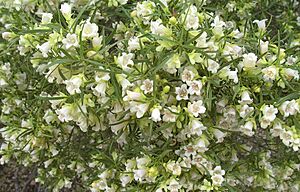False sandalwood facts for kids
Quick facts for kids False sandalwood |
|
|---|---|
 |
|
| Eremophila mitchellii habit | |
| Scientific classification | |
| Genus: |
Eremophila (plant)
|
| Species: |
mitchellii
|
| Synonyms | |
|
|
The False Sandalwood (scientific name: Eremophila mitchellii) is a special flowering plant found only in Australia. It belongs to the figwort family. This plant is usually a large bush or a small tree. It has bark that peels off, and its flowers are white or cream-colored. It can also grow new plants from its roots. You can find False Sandalwood all over New South Wales and Queensland. Sometimes, it grows so much that it becomes a problem for land where animals graze. However, the plant's oils have useful properties and are sold for different purposes.
Contents
What False Sandalwood Looks Like
False Sandalwood is a large bush or a small tree. It can grow up to 10 m (30 ft) tall, but it's usually between 2 to 6 m (7 to 20 ft) high. It has light grey bark that often flakes off in small pieces.
The branches and leaves are smooth and sometimes sticky. This stickiness comes from a natural resin. If you crush the leaves, they smell nice. The leaves grow one after another along the branches. They are long and narrow, about 24–55 mm (0.9–2 in) long and 2–5.5 mm (0.08–0.2 in) wide. They often have a small hook at the tip.
False Sandalwood Flowers and Fruits
The flowers grow in groups of 2 or 3 where the leaves meet the stem. They are on sticky stalks about 4.5–7 mm (0.2–0.3 in) long. Each flower has 5 white to cream-colored parts called sepals. These are about 4–9.5 mm (0.2–0.4 in) long.
The petals are 10–18 mm (0.4–0.7 in) long and form a tube. This tube is usually white or cream, sometimes light pink. It has spots inside and is filled with soft hairs. Two of the flower's pollen-making parts, called stamens, are hidden inside the tube. The other two might stick out a little.
False Sandalwood usually flowers from September to November. After flowering, it produces oval-shaped fruits. These fruits are typically 4–7 mm (0.2–0.3 in) long and have a hard outer layer.

Naming the False Sandalwood
The False Sandalwood was first officially described in 1848. A botanist named George Bentham gave it its scientific name. A botanist is a scientist who studies plants. The second part of its scientific name, mitchellii, honors an explorer named Thomas Mitchell.
This plant has many other common names. People also call it buddah, buddha, budtha, sandalwood, native sandalwood, bastard sandalwood, sandalbox, and rosewood balvory.
Where False Sandalwood Grows
False Sandalwood grows west of the Great Dividing Range in Australia. You can find it north of Hillston in New South Wales and across eastern Queensland. It can grow in many different types of soil and is common in most woodland areas.
How False Sandalwood Affects its Environment
This plant can spread quickly into pasture land in New South Wales and Queensland. Pasture land is where animals like cows graze. Because it spreads so easily, it is not allowed to be grown in Western Australia.
False Sandalwood can regrow very fast from roots left in the ground. It also spreads quickly from its seeds. Some tiny native scale insects can kill E. mitchellii. However, these insects need to be placed directly onto the plant to work.
Uses of False Sandalwood
False Sandalwood has been used for different purposes by people.
Traditional Uses by Indigenous People
Aboriginal people used False Sandalwood for medicine. They used it to help with rheumatism, which is pain in joints and muscles. They also burned the leaves and used the smoke for general health reasons.
Useful Essential Oils
False Sandalwood contains special oils called essential oils. These oils have been used as a mild pain reliever. They are also added to things like soaps and perfumes because they smell good.
The oil from False Sandalwood can fight against some tiny living things called microorganisms that can cause sickness. These include Staphylococcus aureus and Salmonella typhimurium. The oil is also good at killing termites. A product called "Buddha Wood Essential Oil" is also sold.
Growing False Sandalwood in Gardens
Eremophila mitchellii is not commonly grown in gardens. However, it might be a good plant for places with dry weather. It likes full sun and soil that drains water well.
Using False Sandalwood Wood
The wood from False Sandalwood is very hard. It is good for woodturning, which is shaping wood on a special machine. The wood keeps its pleasant smell for a long time, even after it's finished. Because it has a lot of oil, you can polish it to a very shiny finish.
Other Uses of the Plant
In 1889, a book called The Useful Native Plants of Australia mentioned some interesting facts. It said that animals like cattle eat the leaves of False Sandalwood. It also noted that emus eat the seeds of several Eremophila species.

